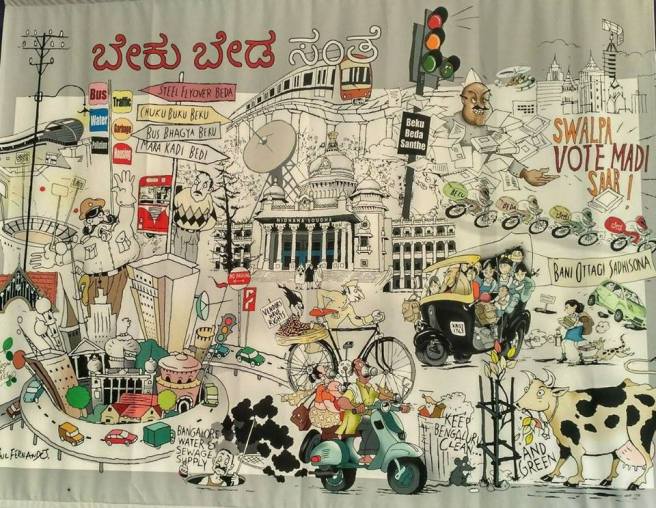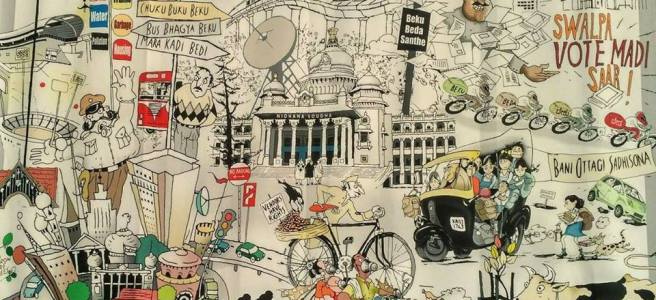
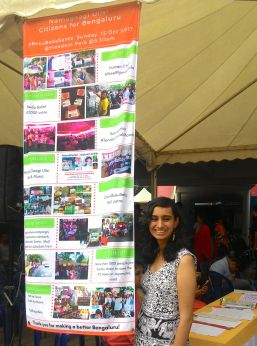 While it is an enjoyable past time throughout India, to engage in heated arm chair debates about why Indian politicians are the worst, while Indian culture is the best debates about why Indian politicians are the worst, while Indian culture is the best, again and again the citizen groups of Bangalore or Bengaluru, continue to demonstrate that it is possible to make positive change happen instead of just sitting, waiting and complaining! Such groups need to emerge and take action in all parts of India to ensure access to drinking water for all and so it is particularly important to understand their dynamics on World Water Day. To gain some insight, I asked some questions to Ritika Sharma, an ardent and sincere volunteer of the ‘Citizens for Bengaluru’ and here’s what she told me…
While it is an enjoyable past time throughout India, to engage in heated arm chair debates about why Indian politicians are the worst, while Indian culture is the best debates about why Indian politicians are the worst, while Indian culture is the best, again and again the citizen groups of Bangalore or Bengaluru, continue to demonstrate that it is possible to make positive change happen instead of just sitting, waiting and complaining! Such groups need to emerge and take action in all parts of India to ensure access to drinking water for all and so it is particularly important to understand their dynamics on World Water Day. To gain some insight, I asked some questions to Ritika Sharma, an ardent and sincere volunteer of the ‘Citizens for Bengaluru’ and here’s what she told me…
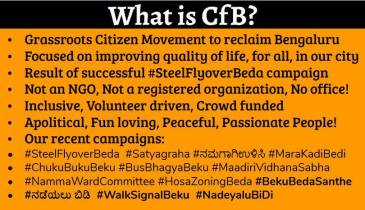 1. Can you please tell us something about the citizen’s movement you are part of?
1. Can you please tell us something about the citizen’s movement you are part of?
Citizens for Bengaluru (CfB) is a voluntary movement of, by, and for the people of Bengaluru. The movement is focused on improving the quality of life, for all, in the city. Many infrastructure and public projects in the city are inadequately reviewed at the concept stage, poorly thought-out, planned and implemented, sometimes in haste. The outcome is that they end up not meeting their intended objectives, often worsen the original problem or create new ones in their place. CfB believes this can be addressed by following due processes, actively involving the public and consulting and leveraging the vast professional and living experience of the city’s citizenry – “The Silent Majority” and the “Fifth Pillar of Democracy”.
We represent the people of the city, and wish to be informed and heard on issues and projects that impact Bengaluru. CfB will be alert, active, engaged and vigilant, at all times, towards these ends. We are an inclusive, volunteer run movement, open to anyone who shares our vision of a better Bengaluru and who may have the inclination and time to contribute to our campaigns and activities.
2. How did you get to join it? What made you join it? – The first event by CFB was the Steel Flyover Beda Human Chain. I went for it because I heard about it on the radio and thought it was something different to do on a Sunday morning and also because I thought my favourite RJ (or Radio Jockey) was going to be there and I could meet her ? Little did I know there would be 8000 people forming the Human Chain. Over time I continued to follow messages on the whatsapp group created for the human chain and I realised how passionate people are and the things they are doing to contribute to the city. It inspired me to start contributing in whatever small way I could. Over time I realised we were really making a difference even though the individual contributions were not necessarily immense. And that motivated me to continue contributing.
3. What are its ultimate targets? – The movement is focused on improving the quality of life, for all, in the city.
4. Can you give us examples of the achievements of the movement?– Steel Flyover Beda movement achieved success when the Chief Minister cancelled the project stating that “if people don’t want it, we won’t build it.” This was the movement which led to the birth of Citizens for Bengaluru and citizen activism in general in the city.
 The Steel Flyover also went into a court case. During this time, the people who had come together to fight for what is right for the city, did not want to let the movement die down. In a brain storming session we realised that public transport is the way forward for the city. Along with railway activist groups CFB did the #chukubukubeku campaign which was for suburban rails in the city. Though the demand had been there for over 20 years, due to lack of political will and many other reasons, it had never got met. Most people of Bangalore did not even know the possibility of a suburban rail, with the existing railways routes. The creative ways in which CFB created awareness and put pressure on the political class led to the actual allocation of funds and formal announcements by the State Government. Major success was achieved with the Centre also allocating funds (17,000 Crore) in this year’s Budget. A few trains have now started running within the city.
The Steel Flyover also went into a court case. During this time, the people who had come together to fight for what is right for the city, did not want to let the movement die down. In a brain storming session we realised that public transport is the way forward for the city. Along with railway activist groups CFB did the #chukubukubeku campaign which was for suburban rails in the city. Though the demand had been there for over 20 years, due to lack of political will and many other reasons, it had never got met. Most people of Bangalore did not even know the possibility of a suburban rail, with the existing railways routes. The creative ways in which CFB created awareness and put pressure on the political class led to the actual allocation of funds and formal announcements by the State Government. Major success was achieved with the Centre also allocating funds (17,000 Crore) in this year’s Budget. A few trains have now started running within the city.
5. How does the movement mobilize people towards its causes? – Mobilization is generally done with the help of social media, print media and Whatsapp. Specific event mobilisations is done by visiting institutions of the target audience Eg. Colleges, Senior Citizen Homes, slums etc.
6. What is this manifesto? Can you give us its three most important points?– Citizens Manifesto is a list of demands (Bekus and Bedas) for 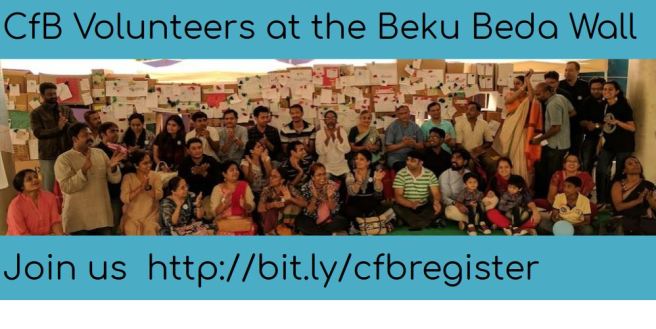 Bangalore categorized under 13 Broad Heads (Sectors of liveability). The starting point of this Manifesto was our event, Beku Beda Santhe which had participation from diverse groups across Bangalore – Resident Welfare Associations, schools, under privileged children, slum children, house-maid’s unions to name a few.
Bangalore categorized under 13 Broad Heads (Sectors of liveability). The starting point of this Manifesto was our event, Beku Beda Santhe which had participation from diverse groups across Bangalore – Resident Welfare Associations, schools, under privileged children, slum children, house-maid’s unions to name a few.
During this event, everybody was given an opportunity to come up to the Beku Beda Santhe wall and write their demands. After this, volunteers consolidated the demands and the manifesto was made. Under each broad head there are the principles (best practices to drive decisions in each sector) and the demands. (specific, tangible areas for improvement).
If I have to pick three demands, my favourites would be “Integrate Public Transport with last mile connectivity”; “Toilets must be clean, usable, accessible for all” and “Disabled-friendly footpaths and public spaces”
CFB ManifestoA4 booklet english
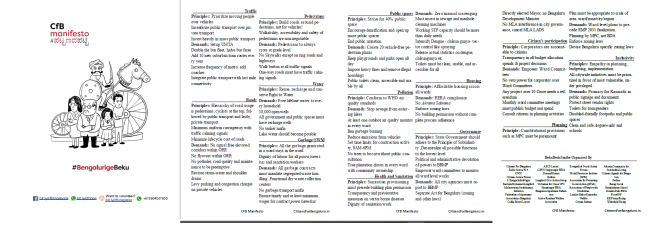
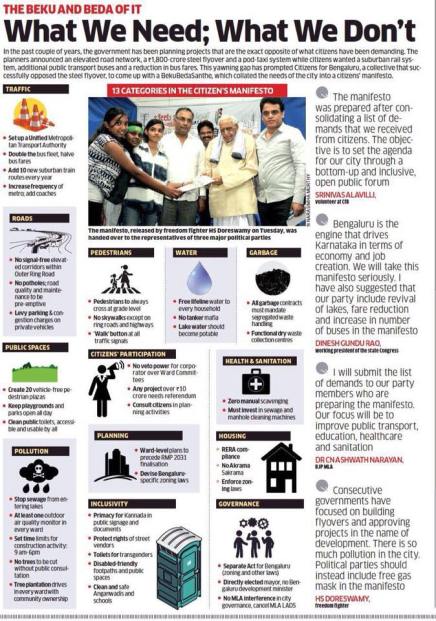 7. There is a lot of news about lakes burning in Bengaluru and about water drying out?
7. There is a lot of news about lakes burning in Bengaluru and about water drying out?
Is your movement concerned in any way in addressing these problems? – While CFB has not done anything directly towards lakes, water, garbage and pollution are all important heads in the manifesto.We are concerned about civic infrastructure of Bangalore and lakes are definitely part of that. Also several volunteers are actively involved in their respective community lake conservation groups. Under the heading “Water” we have free lifeline water to every household, 10,000 open wells and potable lake water as some of the demands. Making lake water potable would cover a lot of the end to end actions including elimination of sewerage and debris dumping into lakes, to cleaning it, to ongoing sustainable maintenance and that implies involving locals for maintenance to avoid encroachment and sustain water quality. Lake water used to be potable in Hale Bengaluru. Our demand is for it to return to that pristine state.
With summer starting in Bangalore we are planning an event to highlight one of the demands on “Water” in March or April.
8. By the way what do you get out of being part of this group? Warm glow? Or has it helped you in any other way?– Personally, being a part of this group has helped me in many ways – I had my first experience of being on TV as part of a panel discussion ? My communication skills have improved; I spend my weekends productively and contribute to the improvement of the city. I have made good friends and contacts. I am up-to date/ aware of infrastructure projects in the city. Also since I have been an ardent user of public transport for the last 6 years or so, the concept of improvement of bus services in the city or introduction of suburban rail to reduce traffic congestion is something I relate to and feel passionately about.
Currently, with the upcoming elections in mind,
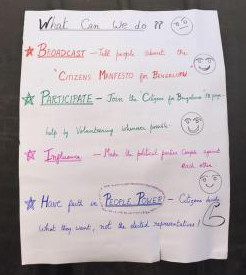 we have theWhat can we do citizens manifesto, about which we are creating awareness, both among the political class – so that they can include it in their own party manifestos and among ordinary citizens – to highlight the point that what is good and bad for the city should not be decided entirely by the political class but by the ordinary citizens. Citizens have a right to ask for what they want and if people come together and ask for it, they will get it. So help is required to spread the word about the manifesto and when we do large events we need public participation in large numbers. We are also trying to reach out to schools, colleges, companies or any large gatherings so any connect with such institutions would be helpful.
we have theWhat can we do citizens manifesto, about which we are creating awareness, both among the political class – so that they can include it in their own party manifestos and among ordinary citizens – to highlight the point that what is good and bad for the city should not be decided entirely by the political class but by the ordinary citizens. Citizens have a right to ask for what they want and if people come together and ask for it, they will get it. So help is required to spread the word about the manifesto and when we do large events we need public participation in large numbers. We are also trying to reach out to schools, colleges, companies or any large gatherings so any connect with such institutions would be helpful.
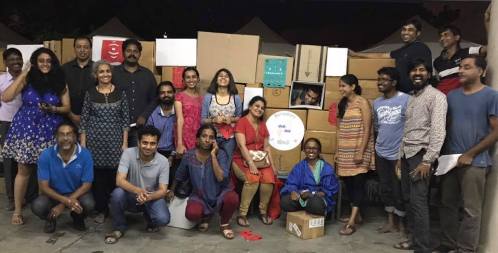 Also, anyone who shares our vision of a better Bengaluru and who may have the inclination and time to contribute to our campaigns and activities is most welcome to join us as a volunteer. The links to the facebook and whatsapp groups are there below, along with link to the presentation on the Manifesto.
Also, anyone who shares our vision of a better Bengaluru and who may have the inclination and time to contribute to our campaigns and activities is most welcome to join us as a volunteer. The links to the facebook and whatsapp groups are there below, along with link to the presentation on the Manifesto.
Important Links – Citizens for Bengaluru (Facebook)
BengaLurigeBeku-Parties (Manifesto PPT)
CfB-BekuBedaSanthe2017 (Whatsapp Group)
Art work by Paul Fernades
